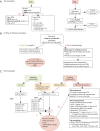Management of the sensitized pediatric heart transplant patient
- PMID: 31728323
- PMCID: PMC6825961
- DOI: 10.21037/tp.2019.07.13
Management of the sensitized pediatric heart transplant patient
Abstract
Despite advancements in transplant immunosuppression and techniques for managing critically ill patients awaiting heart transplantation, children who are immunologically sensitized to human leukocyte antigen remain at increased risk for morbidity and mortality, both while awaiting and after heart transplant. In this review we will discuss the epidemiology of sensitization, review the immunologic basis and methods of human leukocyte antigen antibody detection, describe outcomes for sensitized pediatric transplant candidates, and consider both pre- and post-transplant management options for sensitized patients.
Keywords: Pediatric; antibodies; heart transplantation; human leukocyte antigen (HLA); sensitization.
2019 Translational Pediatrics. All rights reserved.
Conflict of interest statement
Conflicts of Interest: The authors have no conflicts of interest to declare.
Figures


References
-
- Rossano JW, Cherikh WS, Chambers DC, et al. The International Thoracic Organ Transplant Registry of the International Society for Heart and Lung Transplantation: Twenty-first pediatric heart transplantation report-2018; Focus theme: Multiorgan Transplantation. J Heart Lung Transplant 2018;37:1184-95. 10.1016/j.healun.2018.07.018 - DOI - PubMed
Publication types
LinkOut - more resources
Full Text Sources
Research Materials
